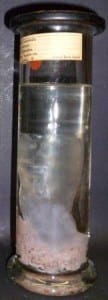Specimen of the Week: Week Six
By Emma-Louise Nicholls, on 21 November 2011
 This week’s specimen is beautiful but deadly, squishy but complex, and not entirely what it seems. This week’s specimen of the week is…
This week’s specimen is beautiful but deadly, squishy but complex, and not entirely what it seems. This week’s specimen of the week is…
**!!!The Portuguese man o’ war!!!**
1) The infamous Portuguese man o’ war, also known as the blue bottle, is not a true jellyfish. It is not even a single animal. A man o’ war is actually a colony of tiny individuals called zooids, that are incapable of surviving independently from the colony.
2) The man o’ war floats on the top of the water whilst the majority of the colony hangs just below the surface. The colony is kept afloat by an air bladder.
3) The tentacles of the Portuguese man o’ war contain stinging cells that carry poison. Washed-up dead colonies, and tentacles that are no longer attached to the body, are both still toxic. Man o’ war specimens that have been in the Museum for decades could also still be poisonous. To prevent accidents however, the specimens are ‘fixed’ with chemicals to take away the stinging capabilities, before they are preserved in jars.
4) The blanket octopus is unaffected by the man o’ war’s toxins. In a feat of genius resourcefulness, the crazy critters have been observed tearing tentacles off of man o’ war colonies to use as a defense weapon!
5) The man o’ war has no means of locomotion and is entirely at the mercy of wind, currents and tides. The small part of the colony that is held above the water’s surface acts as a primitive sail.
Click here if you would like to see images of man o’ war colonies.
If you would like to adopt a man ‘o war specimen at the Grant Museum drop us an email at zoology.museum@ucl.ac.uk.
 Close
Close




